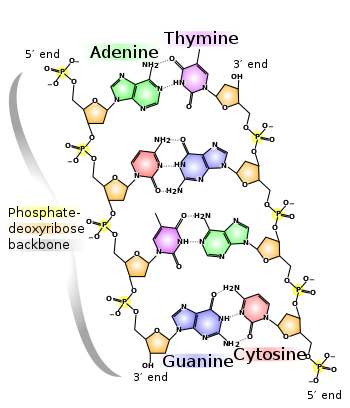 |
| The structure of deoxyribonucleic acid (DNA), the picture shows the monomers being put together. (Photo credit: Wikipedia) |
There are about 60,000 billion cells found in the human body. It includes muscle cells, cheek cells, and white blood cells. Each cell contains the whole genetic information which is the DNA (deoxyribonucleic acid). The nucleus inside the cell holds the DNA or chromosomal DNA that consists of Y chromosomal DNA, X chromosomal DNA, and autosomal DNA. The external part of the nucleus holds mitochondrial DNA (mtDNA). The autosomal DNA comes from both the mother and the father, Y chromosomes are inherited by a son from his father, and mtDNA comes from the mother only.
There are advancements made in testing DNA to meet various areas of interests. For example, the most common uses of DNA are related to finding criminals and proving paternity. But today, genealogy research also uses DNA testing.
For so many years, genealogy has become an important element of society and a favorite hobby of some enthusiasts. Although this is more rewarding, somehow it brings frustrations even to expert genealogists. It can be very time consuming when doing paper research. More often, it can lead to illegible and damaged documents. But, DNA testing provides quick results without questioning its authenticity or quality. Moreover, the genetic genealogy results can endure the tests of time.
1. Mitochondrial testing is utilized for tracing the maternal heritage of a person. The mtDNA testing is very important since genealogists are mostly females. When they marry, maternal lines are often lost because of changing their surnames. In this manner, they can learn and trace their maternal ancestry.
There are advances made in understanding genetics and using laboratory techniques in helping a person to identify maternal lineage through mtDNA tracing services. The distinct mtDNA of person is analyzed and compared to the databases of other samples of mtDNA worldwide, revealing information about the lost ancestry.
The mtDNA remains nearly unchanged even for so many years. You can share the same type of mtDNA with your mother, maternal grandmother, and maternal great-grandmother. The same exact mtDNA code can track your direct maternal lineage way back from the time where mtDNA code's natural mutation occurred.
Women who are living today can trace their origins 150 thousand years ago through natural mutations or mitochondrial eve. In connection with matrilineal descent, eve is the common ancestor. But it doesn't necessarily imply that eve is the only woman who lived in that era. There were also other women alive but only the lineage of eve has survived.
2. Y chromosomal DNA testing is the most commonly used form of genetic genealogy testing. Some people can even trace if a deceased man is related to them by conducting this test.
Like mtDNA, Y chromosomes can be also traced back from one prehistoric father, Adam. The DNA mutation of the first Y chromosomes naturally occurs over many generations. Determining the present Y chromosomes can trace your paternal lineage through searching the Y database worldwide.
Moreover, genealogists can find out if two people are related because they have similar surnames through Y chromosomes testing. It is not impossible since, in most cultures, surnames or family names are inherited by children from their fathers like the Y chromosomal DNA.
A successful genealogy research lies on DNA testing because its usefulness is proven as time has passed by.
No comments:
Post a Comment